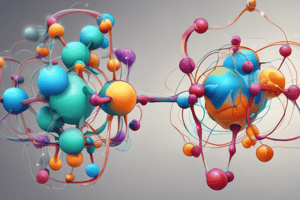Podcast
Questions and Answers
What type of bond is formed between a metal and a nonmetal?
What type of bond is formed between a metal and a nonmetal?
- Hydrogen bond
- Covalent bond
- Ionic bond (correct)
- Metallic bond
Covalent bonds are characterized by the complete transfer of electrons.
Covalent bonds are characterized by the complete transfer of electrons.
False (B)
What is the general formula for a decomposition reaction?
What is the general formula for a decomposition reaction?
AB → A + B
In a double displacement reaction, two compounds exchange ______ to form two new compounds.
In a double displacement reaction, two compounds exchange ______ to form two new compounds.
Match the following types of chemical bonds with their characteristics:
Match the following types of chemical bonds with their characteristics:
Which factor significantly influences the bond formation between atoms?
Which factor significantly influences the bond formation between atoms?
Hydrogen bonds are stronger than covalent bonds.
Hydrogen bonds are stronger than covalent bonds.
What is the role of the octet rule in chemical bonding?
What is the role of the octet rule in chemical bonding?
In redox reactions, oxidation refers to the ______ of electrons.
In redox reactions, oxidation refers to the ______ of electrons.
What type of reaction involves the transfer of protons between an acid and a base?
What type of reaction involves the transfer of protons between an acid and a base?
Flashcards
Ionic Bond
Ionic Bond
A chemical bond formed between a metal and a nonmetal, involving the transfer of electrons from the metal to the nonmetal, resulting in positively and negatively charged ions. Characterized by high melting and boiling points, high lattice energies, and strong electrostatic attraction.
Covalent Bond
Covalent Bond
A chemical bond formed between two nonmetals, involving the sharing of one or more pairs of electrons between atoms. Characterized by low melting and boiling points, relatively low bond energies, and can be polar or nonpolar.
Metallic Bond
Metallic Bond
A chemical bond formed between metal atoms. Valence electrons are delocalized, creating a 'sea of electrons'. This results in solid, malleable and conductive materials with high melting and boiling points and high electrical conductivity.
Hydrogen Bond
Hydrogen Bond
Signup and view all the flashcards
Electronegativity
Electronegativity
Signup and view all the flashcards
Electronegativity Difference
Electronegativity Difference
Signup and view all the flashcards
Synthesis Reaction
Synthesis Reaction
Signup and view all the flashcards
Decomposition Reaction
Decomposition Reaction
Signup and view all the flashcards
Single Displacement Reaction
Single Displacement Reaction
Signup and view all the flashcards
Double Displacement Reaction
Double Displacement Reaction
Signup and view all the flashcards
Study Notes
Chemical Bonding
- Chemical bonding governs compound formation and atomic interactions.
- It's the force holding atoms together, creating stable molecules and materials.
Types of Chemical Bonds
-
Ionic Bonds:
- Formed between a metal and a nonmetal.
- Involve complete electron transfer from metal to nonmetal.
- Create positively and negatively charged ions (cations and anions).
- High melting and boiling points, high lattice energies.
- Examples: NaCl (table salt), CaCl₂ (calcium chloride)
-
Covalent Bonds:
- Formed between two nonmetals.
- Involve electron sharing between atoms.
- Create stable, neutral molecules.
- Low melting and boiling points, relatively low bond energies.
- Examples: H₂O (water), CH₄ (methane)
-
Metallic Bonds:
- Formed between metal atoms.
- Involve delocalized valence electrons (a "sea of electrons").
- Result in solid, malleable, conductive materials.
- High melting and boiling points, high thermal and electrical conductivity.
- Examples: Cu (copper), Al (aluminum)
-
Hydrogen Bonds:
- A special dipole-dipole interaction.
- Formed between a hydrogen atom bonded to a highly electronegative atom (N, O, F) and another highly electronegative atom.
- Relatively weak, but can significantly influence molecular properties.
- Examples: H₂O (water), NH₃ (ammonia)
Factors Influencing Bond Formation
-
Electronegativity Difference:
- Measures atoms' ability to attract shared electrons.
- Determines bond's ionic or covalent character.
- Higher differences result in more ionic character.
-
Atomic Size:
- Larger atoms form weaker bonds due to increased distance.
- Smaller atoms form stronger bonds due to proximity.
-
Octet Rule:
- Atoms tend to bond to achieve a stable 8 valence electron configuration.
- Exceptions include H (2 electrons) and He (0 electrons).
-
Bond Polarity:
- Unequal electron sharing in covalent bonds.
- Creates partial positive and negative charges (dipoles).
- Influences molecular properties and reactivity.
Chemical Reactions
-
Synthesis (Combination) Reactions:
- Two or more reactants combine to form a single product.
- General formula: A + B → AB.
- Example: 2Na + Cl₂ → 2NaCl
-
Decomposition Reactions:
- A single reactant breaks down into two or more products.
- General formula: AB → A + B.
- Example: 2H₂O → 2H₂ + O₂
-
Single Displacement (Substitution) Reactions:
- One element replaces another in a compound.
- General formula: A + BC → AC + B.
- Example: 2Na + 2HCl → 2NaCl + H₂
-
Double Displacement (Metathesis) Reactions:
- Two compounds exchange ions to form two new compounds.
- General formula: AB + CD → AD + CB.
- Example: NaCl + AgNO₃ → NaNO₃ + AgCl
-
Acid-Base Reactions:
- Involve proton (H⁺) transfer between an acid and a base.
- General formula: HA + BOH → A⁻ + B⁺ + H₂O.
- Example: HCl + NaOH → Cl⁻ + Na⁺ + H₂O
-
Redox (Oxidation-Reduction) Reactions:
- Involve electron transfer between reactants.
- Oxidation: Loss of electrons.
- Reduction: Gain of electrons.
- General example (oxidation): A → A⁺ + e⁻
- General example (reduction): B + e⁻ → B⁻
- Example: 2Na + 2HCl → 2NaCl + H₂ (Na is oxidized, H is reduced)
Studying That Suits You
Use AI to generate personalized quizzes and flashcards to suit your learning preferences.




